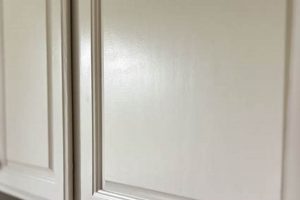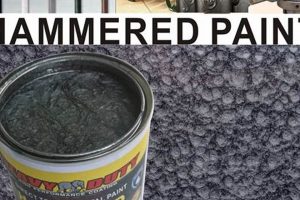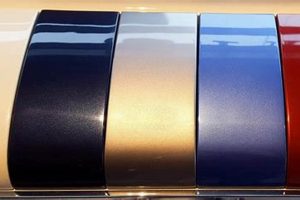An art technique involving the application of pigmented polymer emulsions that dry to a reflective sheen is becoming increasingly popular. This method, characterized by its vibrant colors and durable surface, offers artists a versatile medium for creating eye-catching works. These pieces often exhibit a smooth, almost glass-like appearance, enhancing the visual impact of the artwork.
The high-shine quality not only provides aesthetic appeal but also offers practical advantages. This type of surface is exceptionally resilient, resistant to scratches and easy to clean, ensuring the longevity of the art. Historically, achieving a similar level of luminosity required laborious varnishing processes, but modern formulations have simplified this, making it accessible to both amateur and professional artists.
The subsequent sections will delve into surface preparation techniques, optimal application methods, and considerations for achieving desired effects. A detailed examination of suitable materials and troubleshooting common issues encountered during the process will be provided. Additionally, techniques for preserving the brilliance of the artwork over time will be explored.
Tips for Achieving Superior Results
Employing the following strategies can significantly enhance the quality and longevity of artwork created using a specific technique involving reflective polymer emulsions.
Tip 1: Surface Priming is Essential. Prior to application, ensure the substrate is properly primed. A smooth, even ground minimizes absorption, allowing for uniform coverage and maximizing the reflective qualities of the medium. Apply two to three coats of gesso, sanding lightly between each coat.
Tip 2: Select High-Quality Pigments. The brilliance of the final product relies heavily on the quality of the pigments used. Opt for professional-grade paints known for their lightfastness and color saturation. Student-grade paints may result in duller, less vibrant results.
Tip 3: Apply Thin, Even Layers. Avoid thick, uneven application. Multiple thin coats are preferable to a single thick layer, allowing for proper drying and minimizing the risk of cracking or crazing. Use a soft brush or a palette knife for even distribution.
Tip 4: Incorporate a Self-Leveling Medium. To minimize brushstrokes and achieve a perfectly smooth, reflective surface, consider mixing a self-leveling medium with the paints. This medium helps the paint flow and settle evenly, reducing surface imperfections.
Tip 5: Controlled Drying Environment. Gradual, even drying is crucial. Avoid exposing the artwork to extreme temperatures or rapid temperature fluctuations. A stable environment promotes proper curing and minimizes the risk of surface defects.
Tip 6: Consider a Final Varnish. Although the finish itself offers a level of protection, an additional coat of varnish can enhance durability and UV resistance. Choose a varnish specifically designed for acrylics and apply it evenly once the painting is fully cured.
Implementing these suggestions will contribute to the creation of visually striking and enduring artwork.
The subsequent section will address common challenges and solutions associated with this artistic method.
1. Surface Preparation
The attainment of a highly reflective surface, typical of the art form employing a sheen-enhancing polymer emulsion, is inextricably linked to meticulous preparation of the underlying surface. This initial stage dictates the uniformity, adhesion, and overall aesthetic quality of the final artwork. Imperfections present on the substrate will be magnified by the finish, resulting in an undesirable appearance. For instance, applying the medium to an unprimed canvas results in uneven absorption, producing a mottled and dull surface, negating the intended reflective qualities. In contrast, properly prepared surfaces create an optimal base for uniform application.
The process typically involves the application of multiple layers of gesso, a primer formulated to seal the surface and provide a consistent texture. Sanding between each layer is critical to eliminate irregularities, ensuring that the subsequent application of pigmented polymer emulsions results in a smooth, reflective surface. Consider the example of automotive painting: a flawlessly smooth surface is mandatory for achieving a mirror-like finish. Similarly, in artistic applications, detailed surface preparation directly translates to the degree of luminosity achieved. A smooth surface provides a more reflective base.
Therefore, thorough surface preparation is not merely a preliminary step; it is a foundational requirement. Overlooking this aspect compromises the integrity and intended visual impact of the artwork. Without proper attention to detail in this initial phase, efforts to achieve a vibrant, reflective surface will be fundamentally undermined. The success of this technique is directly proportional to the quality of the surface preparation.
2. Pigment Quality
The selection of high-quality pigments is paramount to achieving the desired visual impact and longevity in artwork utilizing a reflective sheen produced by polymer emulsions. Pigment quality directly influences color saturation, lightfastness, and the overall brilliance of the finished piece. Inferior pigments can result in dull colors, rapid fading, and an uneven surface appearance, thereby diminishing the effectiveness of the technique.
- Color Saturation and Vibrancy
High-quality pigments possess a greater concentration of color particles, resulting in more saturated and vibrant hues. In the context of this technique, this translates to a more visually striking and impactful final product. For example, a painting of a sunset executed with inferior pigments may appear muted and lacking in depth, while the same subject rendered with high-quality pigments will exhibit a richer, more luminous appearance. The reflective surface amplifies the vibrancy, making pigment selection critical.
- Lightfastness and Durability
Lightfastness refers to a pigment’s resistance to fading or discoloration over time when exposed to light. High-quality pigments are typically more lightfast, ensuring the long-term preservation of the artwork’s color integrity. Conversely, pigments with poor lightfastness can fade significantly over time, rendering the artwork visually compromised. Museum conservators prioritize lightfast pigments to ensure artworks retain their original appearance for generations. This consideration is particularly important in pieces designed to be displayed prominently.
- Particle Size and Dispersion
The fineness and dispersion of pigment particles directly affect the smoothness and uniformity of the paint film. High-quality pigments are finely ground and evenly dispersed, resulting in a smooth, consistent surface that maximizes the reflective properties. Coarse or poorly dispersed pigments can create a textured surface that scatters light, reducing the desired sheen. Microscopic analysis of paint films reveals the superior dispersion of high-quality pigments, leading to a smoother, more reflective surface.
- Chemical Stability and Compatibility
The chemical stability of pigments is crucial to prevent unwanted reactions within the paint film, which can lead to discoloration, cracking, or other forms of degradation. High-quality pigments are chemically stable and compatible with the acrylic medium, ensuring the long-term integrity of the artwork. For example, certain pigments may react with the acrylic binder, causing a yellowing effect over time. This is mitigated through the use of high-quality, chemically inert pigments.
In conclusion, the relationship between pigment quality and reflective sheen is direct and substantial. The enhanced reflective surface magnifies both the positive attributes of high-quality pigments and the negative consequences of inferior pigments. Therefore, careful consideration of pigment properties is essential for artists seeking to create lasting works of art employing this specific technique.
3. Application Technique
The realization of a successful piece employing a specific method involving reflective polymer emulsions hinges significantly on the application technique utilized. The manner in which the material is applied directly impacts the uniformity, smoothness, and overall visual impact of the artwork. Improper application can result in uneven surfaces, visible brushstrokes, and diminished reflective properties, negating the intended aesthetic effect. Conversely, meticulous and controlled application techniques contribute to a flawless, glass-like surface, maximizing the luminosity and depth of color.
One crucial aspect is the layering method. Multiple thin coats, as opposed to a single thick coat, are generally preferred. This approach allows for even drying and minimizes the risk of cracking or blistering. For example, applying a thick coat of the medium can lead to the formation of bubbles that become trapped beneath the surface, resulting in visible imperfections and reduced reflectivity. Another key consideration is the choice of application tools. Soft brushes, palette knives, or even spray guns can be employed, each offering distinct advantages and disadvantages. Brushes, for example, can leave visible strokes, while spray guns can provide a more uniform and even application, particularly when working on larger surfaces. However, spray application requires careful control to avoid runs or drips.
In summary, the application technique is not merely a procedural step but an integral component in achieving a high-quality outcome. The control and care exercised during application directly correlate with the aesthetic quality and professional appearance of the artwork. By employing appropriate techniques, artists can unlock the full potential of this process, creating visually stunning and enduring works. Successfully combines technique and materials and result. The next section will consider the implications of employing leveling agents in such an undertaking.
4. Leveling Agents
Leveling agents play a crucial role in achieving the smooth, reflective surface characteristic of a glossy finish achieved through a method involving polymer emulsions. These additives modify the surface tension and flow properties of the paint, influencing the final appearance and tactile quality of the artwork.
- Reduction of Brushstrokes and Surface Imperfections
Leveling agents facilitate the flow of the paint, allowing it to spread evenly and minimize visible brushstrokes. Without these additives, the viscous nature of acrylic paints can lead to uneven surfaces and noticeable texture. For example, in landscape paintings aiming for a smooth, atmospheric effect, the use of a leveling agent ensures a seamless blend of colors, preventing harsh brushstroke demarcations. This is crucial for achieving the intended highly reflective quality.
- Enhanced Gloss and Reflectivity
By promoting a smooth, even surface, leveling agents directly contribute to the overall gloss and reflectivity of the finished artwork. A smooth surface scatters less light and reflects more light in a specular manner, resulting in a brighter, more reflective appearance. This is particularly important in abstract art where surface quality is paramount. A mirror-like surface is dependent upon a complete uniformity.
- Improved Color Blending and Gradation
Leveling agents enhance the blending of colors, enabling smooth transitions and subtle gradations. This is particularly beneficial in techniques such as glazing, where thin layers of color are applied to create depth and luminosity. The agent allows colors to meld seamlessly, resulting in a more refined and sophisticated visual effect. Portrait paintings benefit from this trait.
- Prevention of Cratering and Fisheyes
Leveling agents help to prevent the formation of craters and fisheyes, which are surface defects caused by contaminants or surface tension variations. These defects can significantly detract from the smooth, reflective quality of the finish. By reducing surface tension, leveling agents allow the paint to flow evenly over the surface, preventing these imperfections. Such considerations are essential for large, uninterrupted areas of color.
In conclusion, the use of leveling agents is integral to the successful execution of a glossy polymer emulsion technique. These additives contribute significantly to achieving the desired smooth, reflective surface, enhancing the overall aesthetic appeal and perceived quality of the artwork. Their ability to minimize surface imperfections and improve color blending makes them an indispensable tool for artists seeking professional-grade results. The agent facilitates the process of reflective mediums.
5. Protective Varnishing
Protective varnishing is a critical final step in the creation of artwork incorporating a high-sheen polymer emulsion, significantly impacting the longevity and aesthetic presentation of the finished piece. The inherent characteristic of the finish, its reflectivity, makes it susceptible to environmental factors and physical damage. Varnishing provides a transparent, durable layer that shields the surface from UV radiation, dust, scratches, and atmospheric pollutants. The absence of varnishing exposes the susceptible surface, potentially leading to fading, discoloration, and surface abrasion. A clear illustration is the comparison of two identical paintings: one varnished and the other unvarnished, both displayed in direct sunlight for a year. The unvarnished painting would likely exhibit noticeable color degradation and a duller surface, while the varnished counterpart would retain its original vibrancy and sheen.
Furthermore, varnishing facilitates easier cleaning and maintenance. The smooth, non-porous surface created by the varnish layer prevents dirt and grime from embedding into the paint film, allowing for gentle cleaning without damaging the artwork. The choice of varnish finish gloss, matte, or satin can be tailored to complement the style of the painting and the artist’s preference, though gloss varnishes are typically selected to maintain or enhance the existing sheen. Real-world applications include the restoration of historic paintings. Conservators routinely apply varnishes to protect and revive aged surfaces. This method demonstrates the capacity of varnishes to protect.
In summation, the implementation of protective varnishing is not merely an optional addition but a fundamental element in preserving the integrity and visual appeal of high-sheen artwork. It acts as a shield against environmental hazards, simplifies maintenance, and can be customized to align with the desired aesthetic effect. Without this essential protective layer, artwork created with a shiny reflective emulsion would be vulnerable to degradation, ultimately compromising its longevity and artistic value. The role of varnishing is considered essential to create lasting products.
Frequently Asked Questions About Achieving a Reflective Surface with Polymer Emulsions
The following addresses common inquiries concerning surface preparation, material selection, and application techniques to create the specific effect of artworks with a bright or polished appearance. The aim is to clarify certain points about achieving an exceptional result in the technique.
Question 1: Is specialized priming necessary for achieving optimal adhesion and sheen?
Yes, specialized priming is essential. A properly prepared surface, typically achieved with multiple layers of gesso, ensures uniform adhesion and prevents the underlying substrate from absorbing the paint unevenly, which could compromise the reflective quality of the finish.
Question 2: Does pigment quality significantly impact the final visual outcome?
Absolutely. High-quality pigments offer superior color saturation, lightfastness, and particle dispersion, contributing to a more vibrant, long-lasting, and visually appealing finish. Inferior pigments can result in dull colors and reduced reflectivity.
Question 3: What is the optimal application technique for minimizing brushstrokes and maximizing smoothness?
Applying multiple thin layers, allowing each layer to dry thoroughly, is generally recommended. This approach minimizes brushstrokes and prevents cracking or blistering. The use of a soft brush or, alternatively, a spray gun can further enhance smoothness.
Question 4: How do leveling agents contribute to the overall aesthetic of the medium?
Leveling agents reduce surface tension, allowing the paint to flow evenly and minimizing brushstrokes, craters, and fisheyes. This results in a smoother, more uniform surface, enhancing the gloss and reflectivity of the finished artwork.
Question 5: Is protective varnishing crucial for preserving the reflective quality and longevity of the artwork?
Yes, protective varnishing is essential. A varnish layer shields the surface from UV radiation, dust, scratches, and atmospheric pollutants, preserving the vibrancy and sheen of the finish over time.
Question 6: What is the best practice for cleaning and maintaining these artistic pieces to safeguard its surface?
Gentle cleaning with a soft, damp cloth is recommended. Avoid harsh chemicals or abrasive cleaners, as these can damage the varnish layer and the underlying paint film. Regular dusting can help prevent the buildup of grime.
In summary, achieving a professional-quality and durable outcome in the technique requires careful attention to surface preparation, pigment selection, application technique, the use of leveling agents, and protective varnishing. Neglecting any of these aspects can compromise the final result.
The subsequent section will address techniques for creating textured surfaces.
Conclusion
This exploration of acrylic painting resulting in a reflective surface has underscored the crucial role of surface preparation, pigment selection, application technique, leveling agents, and protective varnishing. Each element contributes significantly to achieving a durable and visually compelling piece of art.
Understanding and mastering these principles empowers artists to create lasting works exhibiting exceptional sheen and color vibrancy. Continued refinement of these techniques ensures the enduring beauty and value of this artistic approach. Further research into innovative materials and methods will undoubtedly expand the possibilities for this art form.







